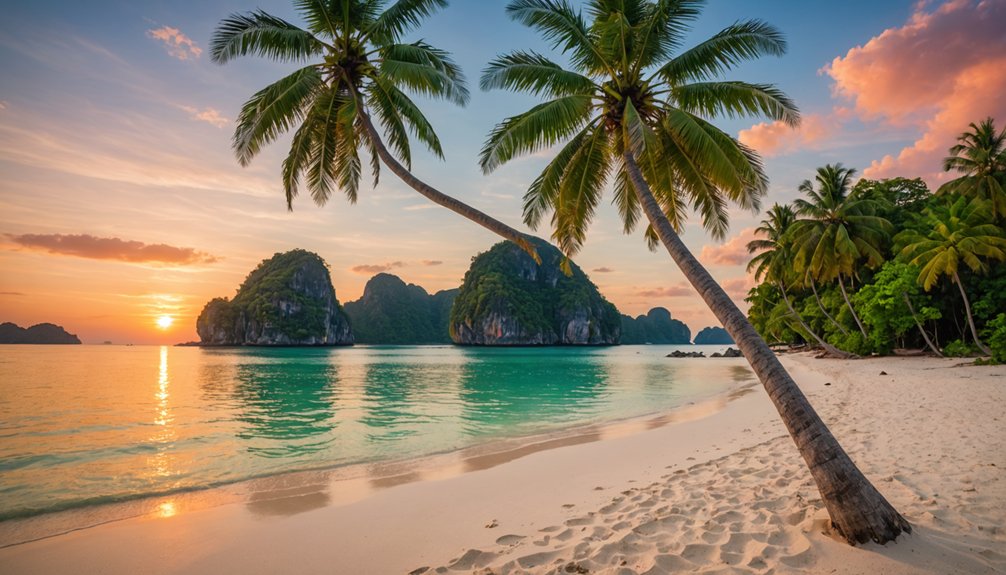You’ll find the best time to visit the Philippines is during the peak season from December to February, when temperatures hover between 24-31°C with minimal rainfall. This period offers perfect conditions for outdoor adventures and water activities, though you’ll need to book accommodations 3-6 months ahead due to crowds. While summer (March-May) brings warmer weather and festivals, peak season delivers that sweet spot of ideal weather and vibrant cultural experiences.
Key Takeaways
- December to February offers peak season with perfect 24-31°C temperatures, ideal weather for outdoor activities and island hopping.
- March to May brings summer festivals, excellent beach conditions, and lower tourist numbers despite higher temperatures.
- June to October experiences monsoon season with frequent rain, but offers significant discounts on accommodations and activities.
- January to March provides budget-friendly travel opportunities with 30-50% discounts on post-holiday rates.
- Avoid the eastern regions during peak typhoon season (August to October) when storm risks are highest.
Peak Season Overview (December to February)
While winter months in many countries bring harsh conditions, December through February mark the Philippines’ peak tourist season, offering near-perfect weather and vibrant cultural festivities. You’ll experience dry season conditions with temperatures ranging from 24°C-31°C, making it ideal for outdoor adventures and water activities.
Be prepared for crowds and higher costs during this prime period. You’ll need to book accommodations 3-6 months ahead, as popular destinations like Boracay and El Nido fill up quickly. Limited inter-island transportation options mean you should secure domestic flights early. Major festivals like Sinulog and Ati-Atihan draw massive crowds, adding to the seasonal rush.
The weather’s perfect for diving in Tubbataha, hiking Mt. Pulag, or spotting whale sharks in Donsol. While coastal areas remain consistently warm, you might want to pack a light jacket for cooler evenings, especially in mountainous regions like Baguio where temperatures can drop to 15°C.
Summer Highlights (March to May)
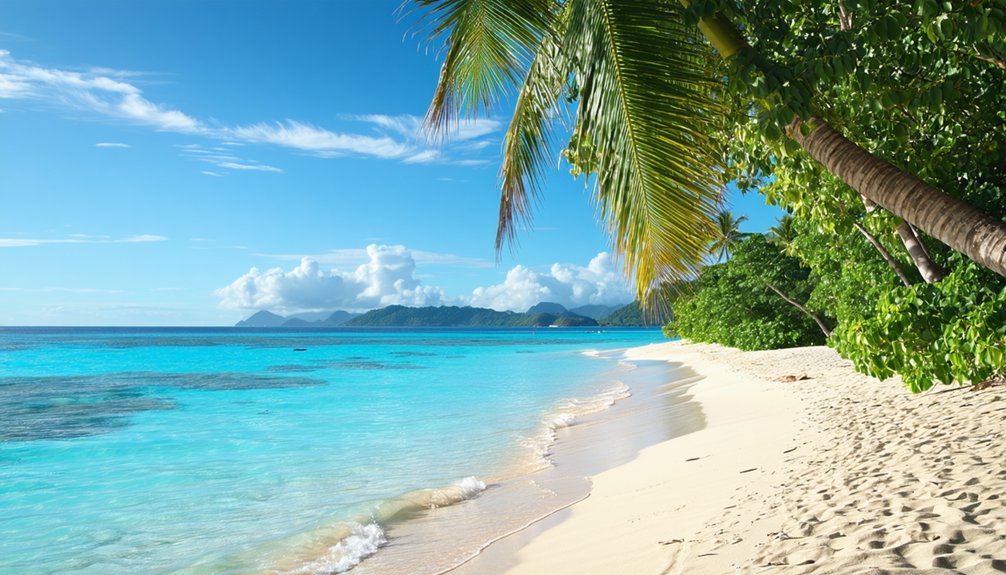
You’ll discover the Philippines bursting with energy during the summer months of March through May, when temperatures soar between 79°F to 93°F and festivals paint the cultural landscape. During this peak festival season, you can explore regional celebrations while taking advantage of prime beach conditions and lower tourist numbers, especially in May’s shoulder season. The combination of clear skies, warm waters, and vibrant local events makes this period perfect for experiencing both traditional festivities and outdoor adventures, from northern Luzon’s rice terraces to Palawan’s pristine shores. Remember to plan your accommodations ahead if visiting during March, as the Holy Week celebrations draw significant crowds of both local and international tourists.
Peak Festival Season
The Philippines erupts with vibrant celebrations during the summer months of March to May, marking the country’s peak festival season. You’ll find the most dynamic cultural heritage exhibitions at this time, from the Kaamulan Tribal Festival showcasing Bukidnon’s indigenous tribe experiences to the artistic fusion of Malasimbo where modern music meets Mangyan traditions.
Don’t miss the nationwide Flores de Mayo celebrations, culminating in ornate Santacruzan processions that transform streets into floral wonderlands. For unique regional flavors, head to La Trinidad’s Strawberry Festival or catch Vigan’s colonial charm during the Viva Vigan Festival of the Arts. If you’re seeking spiritual encounters, join the Holy Week processions or witness the traditional Obando Fertility Rites in Bulacan, where ancient dances still carry profound cultural significance. The Zamboanga Summer Festival brings an exciting mix of tourism activities and cultural shows that highlight the region’s rich heritage.
Hot Beach Adventures
Countless sun-drenched shores beckon beach lovers during the Philippines’ summer months of March to May, when ideal weather conditions create perfect seaside adventures. You’ll find thrilling water sports and pristine marine ecosystems at their peak, with water visibility reaching 40m for shipwreck diving in Coron. Siargao’s world-class surfing waves offer an exhilarating experience for both beginners and expert surfers during this season.
| Activity | Location | Best Time |
|---|---|---|
| Kitesurfing | Bulabog Beach | March-April |
| Scuba Diving | Coron Wrecks | April-May |
| Island Hopping | El Nido | March-May |
Head to Boracay’s White Beach for powdery shores, or escape to San Vicente’s 14.7km Long Beach for untouched coastline. With sea temperatures hovering at 28-30°C and minimal rainfall, you’re guaranteed extended swimming sessions. Just remember to pack SPF 50+ for protection against extreme UV levels and book your island transfers early to avoid the 40% summer surge in demand.
Cultural Event Extravaganza
While summer’s warmth envelops the Philippines, vibrant cultural festivals burst into life across the archipelago from March to May. You’ll witness the grandeur of Flores de Mayo, where communities gather for the Santacruzan parade, featuring intricate religious processions and folklore displays. This spectacular event honors Queen Helena’s historic quest for Christ’s Cross.
Don’t miss the Turumba Festival‘s seven soul-stirring processions, where traditional artisan markets line the streets as locals reenact the Seven Sorrows of Mary. The Pacto de Sangre brings history alive through dramatic reenactments of the Katipunero revolution. During Holy Week, experience profound Semana Santa rituals, from solemn flagellation ceremonies to moving Passion plays. Cap your cultural journey with the Salubong sa Angono, where the emotional reunion of the Virgin Mary and Risen Christ statues marks Easter’s triumph. Visitors to Lucban can marvel at the Pahiyas Philippine Festival, where homes are transformed into stunning displays of colorful agricultural harvests.
Monsoon Season Guide (June to October)

During monsoon season from June to October, you’ll experience a dramatic shift in Philippine weather patterns, marked by afternoon downpours and heightened humidity levels. Despite these conditions, morning hours typically remain sunny, offering prime opportunities for outdoor activities before the rains begin.
Storm preparedness measures become pivotal during this period, especially from August to October when typhoon risks peak in eastern regions like Luzon and Samar. You’ll need to stay flexible with your travel plans and pack appropriate gear, including quick-dry clothing and waterproof essentials. While monsoon travel challenges include potential flight cancellations and flooded roads, you’ll benefit from significant low-season discounts on accommodations and fewer crowds at popular destinations. The country experiences up to 10 typhoons annually during this season, making weather monitoring essential.
The season transforms the landscape into a lush paradise, with enhanced waterfall volumes and vibrant vegetation. Southern regions like Mindanao and the Visayas experience milder conditions, making them more dependable destinations during this period.
Regional Weather Patterns
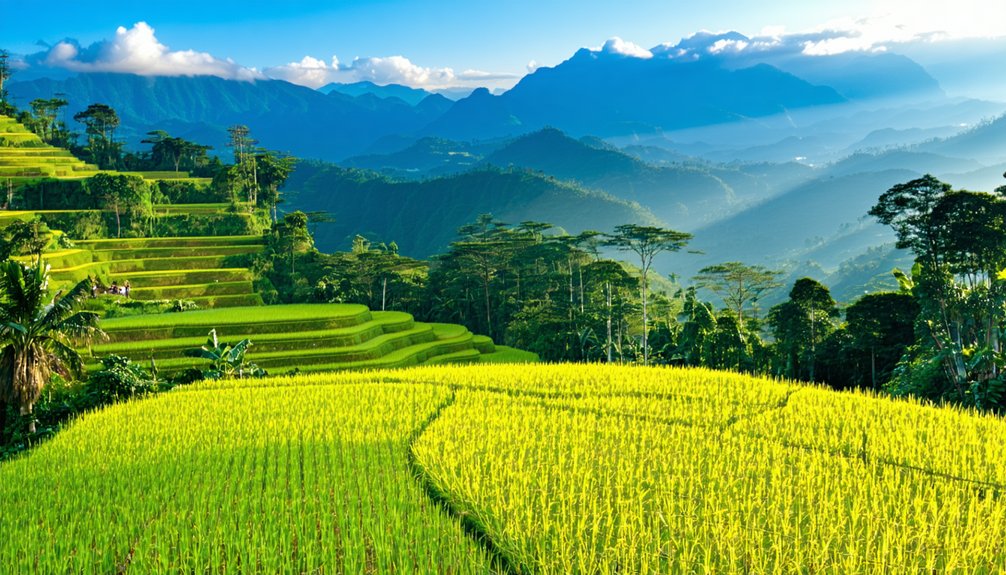
The Philippines’ diverse geography creates distinct weather zones that shape your travel experience across the archipelago. The country divides into four climate types, each offering unique seasonal patterns you’ll want to contemplate when planning your trip.
You’ll find stark contrasts in regional rainfall patterns – from Eastern Samar’s drenching 4,000mm annual rainfall to General Santos City’s relatively dry 1,000mm. If you’re heading to western regions like Manila, expect defined wet (June-September) and dry (November-April) seasons. The eastern areas, including Samar, don’t experience a true dry season, with peak rains from December to February. The northern regions experience a monsoon climate pattern with frequent typhoons throughout the year.
Seasonal temperature variations differ greatly by elevation. While coastal cities maintain temperatures between 21-31°C, highland destinations like Baguio offer temperate 18°C averages. Northern Luzon experiences cooler winters around 25.5°C, while southern islands maintain stable temperatures year-round, making them ideal for travelers seeking consistent weather.
Major Cultural Festivals Calendar
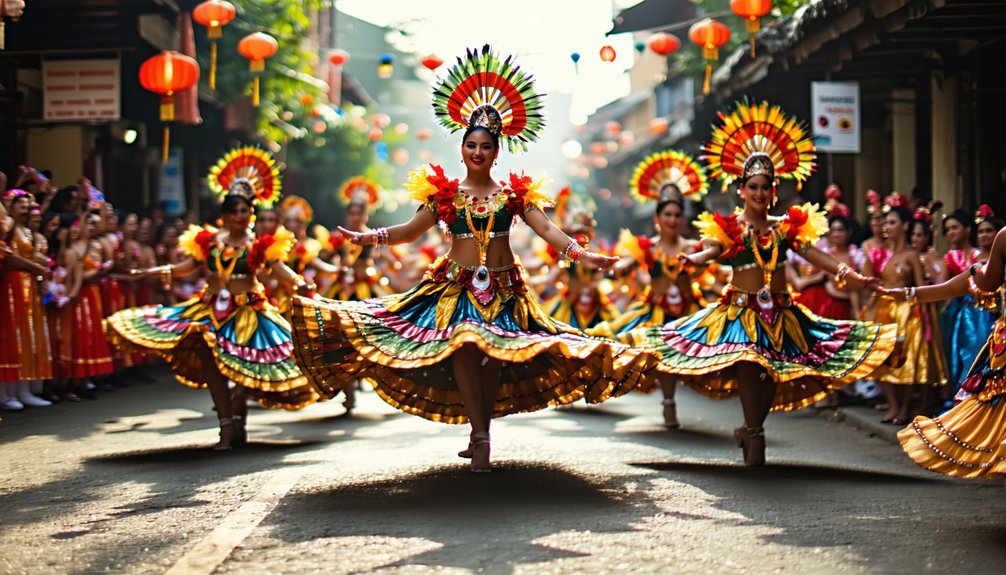
The Philippines’ vibrant festival calendar showcases centuries-old traditions through spectacular fiestas, cultural performances, and religious celebrations throughout the year. You’ll find grand events like January’s Sinulog Festival in Cebu, May’s colorful Pahiyas Festival in Quezon, and October’s MassKara Festival in Bacolod drawing millions of visitors with their unique blend of indigenous, Catholic, and modern Filipino customs. The Feast of the Black Nazarene draws massive crowds to Manila’s Quiapo Church in a powerful display of Filipino Catholic devotion. The country’s festival circuit offers you an authentic glimpse into Filipino heritage, from the solemn Holy Week processions to the joyous Christmas season celebrations culminating in the iconic Giant Lantern Festival of Pampanga.
Traditional Fiestas and Celebrations
Deeply woven into Filipino culture, traditional fiestas and religious celebrations fill the calendar year with vibrant displays of faith, history, and local customs. You’ll discover a mesmerizing blend of traditional costume exhibits and heritage food showcases at these time-honored gatherings. The best festivals take place during the peak season months from December through April.
From January through December, you can immerse yourself in these unforgettable experiences:
- Witness the spectacular Sinulog and Ati-Atihan festivals, where streets come alive with tribal dances and Santo Niño devotions
- Join millions in Manila’s Feast of the Black Nazarene procession
- Experience Holy Week’s profound traditions, from Moriones Festival to Cutud’s dramatic reenactments
- Marvel at May’s Santacruzan and Pahiyas Festival, featuring elaborate floral displays and harvest decorations
- Participate in June’s patriotic celebrations and distinctive local feasts like Balayan’s Parada ng Lechon
Regional Festival Highlights
Packed with vibrant celebrations throughout the year, Philippines’ regional festivals showcase the country’s rich cultural tapestry through elaborate street performances, religious processions, and centuries-old traditions.
You’ll find the most spectacular displays of cultural significance during Sinulog and Ati-Atihan festivals in January, where millions gather for street dancing and tribal celebrations. February brings Baguio’s Panagbenga Festival, transforming the city into a blooming wonderland of floral floats. Community engagement peaks during May’s Pahiyas Festival, where entire neighborhoods compete with creative agricultural displays. Don’t miss June’s Pintados-Kasadyaan Festival in Tacloban, where body-painting traditions honor pre-colonial heritage. For spiritual experiences, join the Flores de Mayo celebrations nationwide or witness the unique fertility rites at Obando Festival in Bulacan.
These vibrant celebrations continue rain or shine throughout the country, ensuring visitors can experience authentic Filipino culture regardless of weather conditions.
Religious Observances and Traditions
Beyond the regional celebrations, religious observances shape the Filipino calendar with nationwide spiritual events that you’ll want to ponder when planning your visit. The country’s deep Catholic roots and diverse religious traditions create distinct periods throughout the year when the atmosphere transforms with spiritual significance.
- Holy Week (March/April) brings solemn Lenten season highlights, with nationwide processions and business closures during the sacred Triduum. During this time, millions of devotees participate in the Visita Iglesia tradition, visiting seven or more churches to offer prayers and meditations.
- Christmas celebrations begin as early as September, peaking from December through February
- All Saints’ Day rituals in November draw millions to cemeteries for family remembrance
- Islamic observances of Eid al-Fitr and Eid al-Adha are celebrated as national holidays
- Religious festival season (January-April) coincides with ideal weather conditions, though expect larger crowds during these significant dates
Budget-Friendly Travel Windows
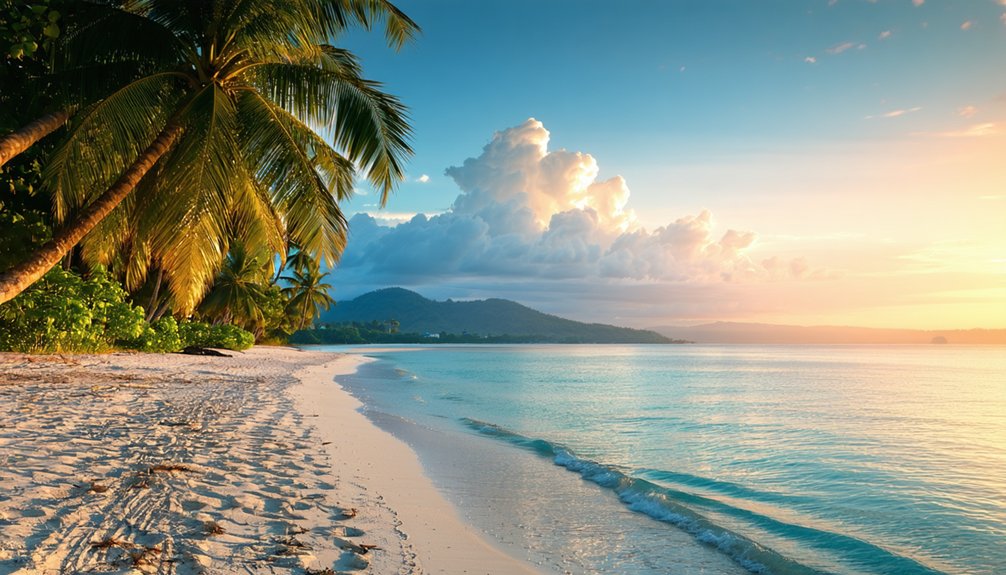
Several budget-friendly windows throughout the year offer savvy travelers significant savings when visiting the Philippines. You’ll find the best deals during January to March, when post-holiday rates drop 30-50% for accommodations, and Philippine travel card perks often include extra baggage allowances on discounted flights.
The May-June changeover period delivers excellent value before peak season, with budget-friendly cruise options and beach resorts offering early-bird discounts up to 40%. This timing coincides with the Pahiyas harvest festival, making it perfect for cultural enthusiasts. September through November presents another prime savings window, as typhoon season reduces tourism, dropping international flight prices by 25-35%.
For maximum savings, consider the wet season from June to October, when all-inclusive resorts slash rates by 50-60%. You’ll encounter minimal crowds at UNESCO sites like Vigan City, and government safety protocols guarantee peace of mind despite occasional storms. Plus, travel insurance costs less during these months, making it an ideal time for budget-conscious adventurers.
Outdoor Activities & Seasonal Timing
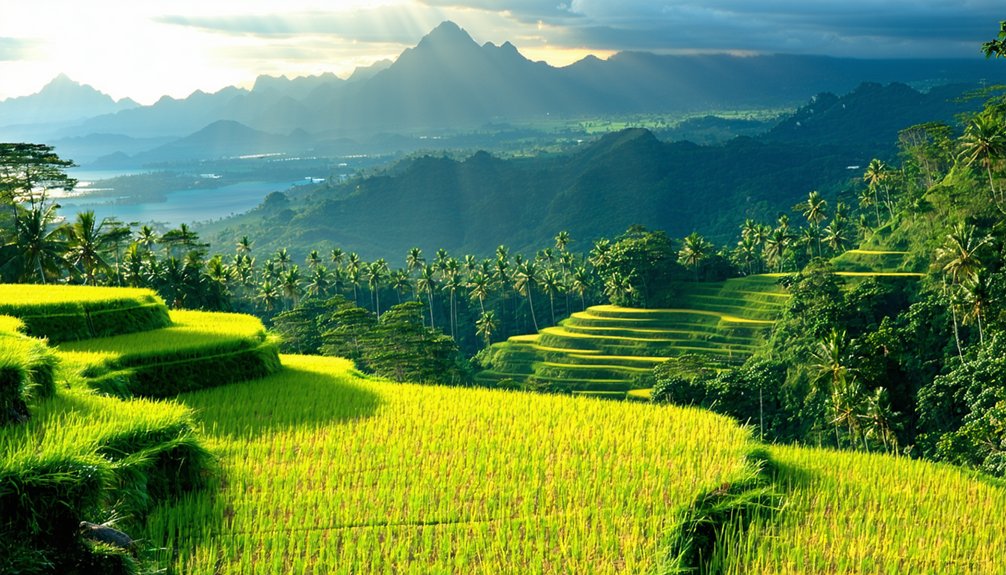
The Philippines’ dual-season climate creates distinct windows for outdoor adventures throughout the year. You’ll find superb hiking conditions during the cool dry season from December to February, while diving visibility peaks between December and April, particularly for exploring Coron’s wrecks and Tubbataha Reef’s vibrant marine life.
Plan your outdoor pursuits according to these seasonal sweet spots:
- December-May: Perfect for beach activities and island-hopping with minimal rainfall
- February-March: Prime time for Mt. Pulag treks and witnessing the iconic sea of clouds
- July-November: Epic surfing conditions on eastern coasts like Siargao
- February-May: Excellent whale shark encounters in Donsol
- December-April: Best underwater visibility for diving and snorkeling
Weather patterns drastically impact activity quality, so timing your visit around your preferred adventures guarantees the most rewarding experience. The Amihan winds from January to February bring pleasantly cool temperatures for sightseeing. Southern regions typically offer more flexibility year-round, with less severe monsoon effects than their northern counterparts.
Essential Weather Safety Tips
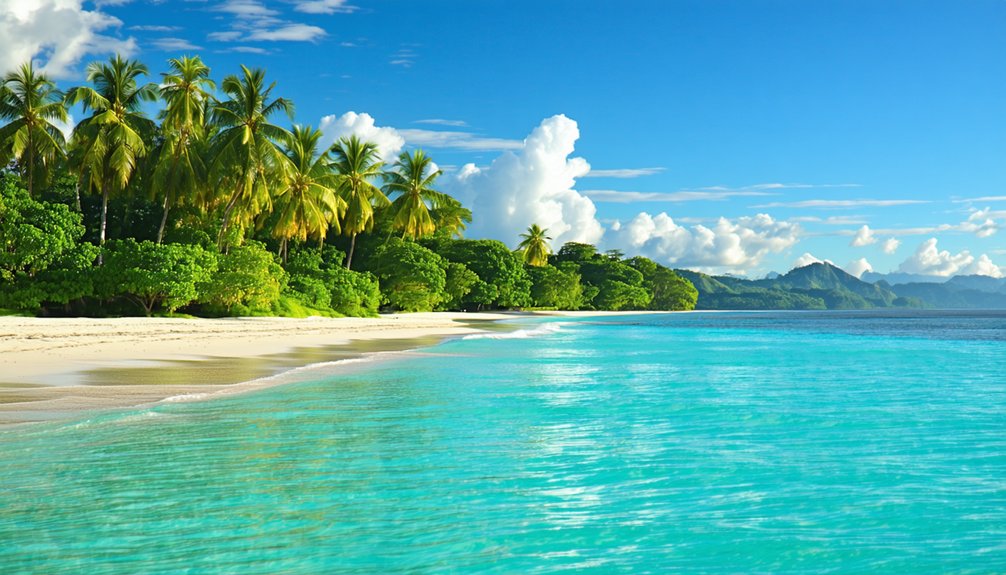
Five critical safety measures can help protect you during the Philippines’ diverse weather patterns. Monitor PAGASA’s website and weather apps for real-time typhoon alerts, especially from June through November. Your storm surge preparedness should include identifying evacuation routes and maintaining a 3-day emergency supply kit.
UV radiation safety demands consistent protection – apply SPF 50+ sunscreen every few hours and wear protective clothing during peak hours (11:00-15:00). You’ll need to drink 3-4 liters of purified water daily to combat the tropical heat. The country’s location in the Pacific Ring of Fire means earthquakes can occur without warning.
Don’t risk driving through flooded roads, as just 6 inches of water can disable your vehicle. Stay alert for landslide warnings in mountainous regions after heavy rains. Keep your freedom to explore by carrying insect repellent with DEET and oral rehydration salts. During severe weather, verify travel plans through official channels and avoid eastern regions during peak typhoon season.

